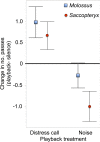Distress Calls of a Fast-Flying Bat (Molossus molossus) Provoke Inspection Flights but Not Cooperative Mobbing
- PMID: 26353118
- PMCID: PMC4564210
- DOI: 10.1371/journal.pone.0136146
Distress Calls of a Fast-Flying Bat (Molossus molossus) Provoke Inspection Flights but Not Cooperative Mobbing
Abstract
Many birds and mammals produce distress calls when captured. Bats often approach speakers playing conspecific distress calls, which has led to the hypothesis that bat distress calls promote cooperative mobbing. An alternative explanation is that approaching bats are selfishly assessing predation risk. Previous playback studies on bat distress calls involved species with highly maneuverable flight, capable of making close passes and tight circles around speakers, which can look like mobbing. We broadcast distress calls recorded from the velvety free-tailed bat, Molossus molossus, a fast-flying aerial-hawker with relatively poor maneuverability. Based on their flight behavior, we predicted that, in response to distress call playbacks, M. molossus would make individual passing inspection flights but would not approach in groups or approach within a meter of the distress call source. By recording responses via ultrasonic recording and infrared video, we found that M. molossus, and to a lesser extent Saccopteryx bilineata, made more flight passes during distress call playbacks compared to noise. However, only the more maneuverable S. bilineata made close approaches to the speaker, and we found no evidence of mobbing in groups. Instead, our findings are consistent with the hypothesis that single bats approached distress calls simply to investigate the situation. These results suggest that approaches by bats to distress calls should not suffice as clear evidence for mobbing.
Conflict of interest statement
Figures






Similar articles
-
Responsiveness to conspecific distress calls is influenced by day-roost proximity in bats (Saccopteryx bilineata).R Soc Open Sci. 2016 May 18;3(5):160151. doi: 10.1098/rsos.160151. eCollection 2016 May. R Soc Open Sci. 2016. PMID: 27293797 Free PMC article.
-
Narrow sound pressure level tuning in the auditory cortex of the bats Molossus molossus and Macrotus waterhousii.Hear Res. 2014 Mar;309:36-43. doi: 10.1016/j.heares.2013.11.004. Epub 2013 Nov 21. Hear Res. 2014. PMID: 24269749
-
Specializations for aerial hawking in the echolocation system of Molossus molossus (Molossidae, Chiroptera).J Comp Physiol A Neuroethol Sens Neural Behav Physiol. 2004 Jul;190(7):561-74. doi: 10.1007/s00359-004-0519-2. Epub 2004 Apr 27. J Comp Physiol A Neuroethol Sens Neural Behav Physiol. 2004. PMID: 15112101
-
Size and quality information in acoustic signals of Rhinolophus ferrumequinum in distress situations.Physiol Behav. 2017 May 1;173:252-257. doi: 10.1016/j.physbeh.2017.02.025. Epub 2017 Feb 24. Physiol Behav. 2017. PMID: 28238774
-
The origins and diversity of bat songs.J Comp Physiol A Neuroethol Sens Neural Behav Physiol. 2016 Aug;202(8):535-54. doi: 10.1007/s00359-016-1105-0. Epub 2016 Jun 27. J Comp Physiol A Neuroethol Sens Neural Behav Physiol. 2016. PMID: 27350360 Review.
Cited by
-
Parent-offspring and inter-offspring responses to conspecific versus heterospecific distress calls in 2 sympatric birds.Curr Zool. 2021 Dec 31;68(6):700-707. doi: 10.1093/cz/zoab103. eCollection 2022 Dec. Curr Zool. 2021. PMID: 36743226 Free PMC article.
-
Vocal sequences suppress spiking in the bat auditory cortex while evoking concomitant steady-state local field potentials.Sci Rep. 2016 Dec 15;6:39226. doi: 10.1038/srep39226. Sci Rep. 2016. PMID: 27976691 Free PMC article.
-
Do bats use guano and urine stains to find new roosts? Tests with three group-living bats.R Soc Open Sci. 2020 Sep 2;7(9):201055. doi: 10.1098/rsos.201055. eCollection 2020 Sep. R Soc Open Sci. 2020. PMID: 33047058 Free PMC article.
-
Distress vocalization sequences broadcasted by bats carry redundant information.J Comp Physiol A Neuroethol Sens Neural Behav Physiol. 2016 Jul;202(7):503-15. doi: 10.1007/s00359-016-1099-7. Epub 2016 Jun 8. J Comp Physiol A Neuroethol Sens Neural Behav Physiol. 2016. PMID: 27277892
-
Continuous low-intensity predation by owls (Strix aluco) on bats (Nyctalus lasiopterus) in Spain and the potential effect on bat colony stability.R Soc Open Sci. 2023 Aug 16;10(8):230309. doi: 10.1098/rsos.230309. eCollection 2023 Aug. R Soc Open Sci. 2023. PMID: 37593707 Free PMC article.
References
-
- De Toledo LF, Fernando C, Haddad B. Defensive vocalizations of Neotropical anurans. S Am J Herpetol. 2009;4: 25–42.
-
- Frankenberg E. Distress calls of gekkonid lizards from Israel and Sinai. Isr J Zool. 1975;24: 43–53.
-
- Staton MA. “Distress Calls" of crocodilians–whom do they benefit? Am Nat. 1978;112: 327–332.
-
- Perrone M. Factors affecting the incidence of distress calls in passerines. Wilson Bull. 1980;92: 404–408.
-
- Hill G E The function of distress calls given by tufted titmice (Parus bicolor): an experimental approach. Anim Behav. 1986;34: 590–598.
Publication types
MeSH terms
LinkOut - more resources
Full Text Sources
Other Literature Sources
Miscellaneous

